Content
Topic of today's article: features of Brilliant raspberries: description of the variety, cultivation. Raspberry is a perennial shrub plant. The plant and its unique properties have been known since ancient times. As a horticultural crop, raspberries have been cultivated in Europe since the 16th century. The wild-growing raspberry is also known, but its cultivated varieties are among the favorite among both amateur gardeners and professionals. Each berry weighs an average of 4 g and consists of about a hundred drupe seeds. What explains the popularity of raspberries?
Raspberry benefits
Raspberries have a pleasant taste and aroma. The popularity of culture is also due to its remarkable beneficial properties.
Useful properties of raspberries:
- Neutralization of free radicals in the body, which prevents damage to cellular structures and the appearance of neoplasms. Raspberries inhibit the growth of malignant cells due to ellagic acid (the strongest anticarcinogen).
- The high content of salicylic acid in berries contributes to the prevention of cardiovascular diseases.
- Improving the permeability of blood vessels from the consumption of berries.
- Regular consumption of raspberries reduces the likelihood of vision loss in older people.
- Pronounced anti-aging effect of raspberries.
- Thanks to vitamin C, which is abundantly contained in raspberries, the body's immunity is strengthened. Resistance to bacterial and viral infections increases. The anthocyanins contained in berries also have a pronounced antifungal effect.
- Despite the high sugar content, the consumption of raspberries does not cause an increase in blood sugar levels. Therefore, raspberries are useful for diabetic patients.
- Raspberries are a great helper for those who are struggling with excess weight.
- Raspberries have anti-inflammatory, antipyretic and analgesic effects. The famous tea with dried raspberries for colds is a vivid evidence of the benefits of these berries. For the same reason, berries are useful for people suffering from joint pain.
Raspberry leaf tea is good for everyone, but especially for pregnant and lactating women. It, like berries, reduces the manifestation of toxicosis in pregnant women, improves lactation, and promotes faster recovery of a woman after childbirth.
For all its wonderful qualities, raspberries are very unpretentious, grows well and bears fruit even with minimal attention. However, proper care makes it possible to achieve excellent yields of berries and avoid damage to bushes and berries by pests and diseases.
Raspberry Shiny: description
The "Brilliant" raspberry variety was bred by employees of the Siberian Research Institute of Horticulture.
The Brilliant variety is based on raspberry varieties:
- Cumberland.
- Malling Landmark.
The variety is distinguished by increased winter hardiness, drought resistance, low susceptibility to fungal infections and pests. The declared frost resistance of raspberries is -34 degrees. In fact, raspberry bushes can withstand much lower temperatures (according to gardeners, 45 degrees below zero is far from the limit). Raspberry Brilliant unpretentious in care, the bushes tolerate adverse weather conditions well. A variety of universal use. The plant is medium-sized (up to 1.5 m), with elastic shoots of medium power.
The berries are large (the weight of one is from 2.5 to 5.5 g). The pulp is dense, dark red "ruby" saturated color, glossy-shiny (hence the name). Raspberries "Brilliant" are successfully grown not only in Siberia, but also in other regions of the country. The berries ripen in August. Berries are picked in 5-6 stages. An important advantage of the variety is that the berries do not fall off the bush. At the same time, they are very easy to pick from the bush. The variety tolerates the transportation of berries well over long distances.
Variety Shiny - universal. Pleasant sweet and sour taste of raspberries, delicate aroma, high percentage of sugar and vitamins make the berries quite suitable for fresh consumption and for making preserves, jams, compotes.
It is necessary to buy Shiny raspberry seedlings (like other varieties) in proven, well-proven farms. Saplings bought from dubious sellers will not allow you to fully appreciate all the advantages of the variety.
Landing
You can plant raspberry bushes both in spring and autumn (September-October). Raspberries are light-requiring, therefore, under the raspberries, you need to select an area well-lit by the sun. If you choose a shady corner, then the young stems on the bushes are strongly elongated, shading the fruits. Naturally, one cannot expect a good harvest from the variety in this situation.
There are no strict regulations regarding the soil. Raspberry bushes thrive both on black soil and on loamy soils. More requirements for soil reaction. The optimal pH value for planting raspberry bushes is 5.7-6.5.
Raspberries grow poorly both in lowlands and in an elevated area. The water stagnates in the lowland, and on the steep slope the bushes will dry out. The best option is a flat area. As a last resort with a slight bias.
Legumes and cereals are favorable for planting under raspberries. And nightshades (tomatoes, eggplants, peppers) are categorically not suitable for the subsequent planting of bushes.
If you plan to plant raspberries in your summer cottage, you can plant bushes in partial shade near the fence or near outbuildings. Will grow well, proven. On the traditional "six hundred square meters" especially you do not roam, so you have to save space. The advantage of this location of raspberries is that in winter these places are better covered with snow. The risk of freezing out raspberry bushes is much less.
Another requirement is regarding groundwater. Raspberries do not tolerate high groundwater locations. The harvest will turn out to be poor, and the bushes will die off quickly.
Spring planting
The procedure for the autumn and spring planting of raspberry bushes is no different, but the preparation is slightly different.
For spring planting, you need to do the following:
- In advance (preferably in the fall), add ash and humus to the soil.
- Remove weeds from the soil before planting.
- Prepare planting pits so that the root of the plant can fit freely in the hole.
- The interval between the pits must be at least 0.5 m. The minimum distance between the rows is 1.5. Bushes grow quickly, so a larger distance is needed so that the plants do not drown out each other.
If the area of the site allows, you can plant the bushes in a checkerboard pattern.
Raspberries spread over the site very quickly. Therefore, it is advisable to provide restrictions even at the landing stage. Dig in metal or boards 0.2-0.3 m into the ground, which will create an obstacle for the further spread of the roots of the plant. The barrier can be created from slate or roofing material.
If the seedlings are large, they can be used for planting supports or trellises.
Planting raspberries in autumn
Experts advise to approach the choice of raspberry variety for autumn planting with extreme caution, as there is a risk of winter freezing. The "Blestyashchaya" variety is suitable for these purposes, since it is characterized by increased winter hardiness. Planting time depends on the region. For the Middle Lane, this is the end of September - mid-October. During the winter, young bushes "rest", and in spring they start growing.
For autumn planting, robust-looking raspberry seedlings, which have well-formed shoots, are selected. You can get a young seedling by carefully separating it from an adult bush. At the same time, it is necessary that the height of the planting material does not exceed 40 cm. If you take a bush that is too high for planting, raspberries will spend all their efforts on survival, which will delay the harvest for a year. The minimum distance between rows is 1.5 m. The interval between adjacent raspberry bushes is 50-60 cm. The procedure for planting raspberries is as follows:
- Dig a trench or planting holes 30 cm deep.
- Place a layer of top dressing on the bottom. Per 1 hole, 0.5 buckets of humus, 10 g of superphosphate and 20 g of potassium fertilizers are obtained.
- Plant roots are best positioned horizontally. In this case, care must be taken that individual roots are not directed upwards.
Autumn mulching
Mulching is raspberry's favorite procedure. The soil around the bushes is covered with organic material. It can be shavings, sawdust, straw, humus. Fallen leaves or grass left over from weeding are suitable as mulch. Gradually, the organic mass will rot and become a good source of nutrients for raspberry bushes.
Raspberry care at different times of the year
You need to work with raspberry bushes immediately after stable warm (about +5 degrees) days have come.
Spring revision
During the inspection, you need to analyze how the raspberries overwintered. First, cut off the old shoots from the bushes, and also remove the frozen ones. Frozen tops are cut to live buds. In this case, the shoots will quickly gain strength and you can count on good fruiting.
Be sure to clean out old leaves and grass debris from under the bushes. To avoid contamination, it is better to burn them right away. This way, you will be able to avoid infections.
If raspberries were bent to the ground for wintering, you need to free them. If this is not done, the kidneys near the ground can die from frost.
Tying
This is the next stage after the "preventive examination" after the spring revision. For the tie, install the trellises (at a height of approximately 70 and 120 cm). You need to tie raspberry shoots in two places. To do this, use hemp twine or soft textile ribbons. Tie the bush not very tightly, so that it does not fall over.
Raspberry pruning
This is a later spring leaving. Pruning is needed during the period when the buds are blooming. All shoots are cut, up to the first blossoming bud. This also applies to non-frostbitten tops. Pruning stimulates abundant fruiting and lateral shoot formation.
Tillage
You should not dig up the soil in the raspberry tree in the spring. The roots of raspberry bushes are shallow (20-30 cm), so digging can harm the root system.
You can use compost, humus, peat, or rotted hay as mulch. Before mulching the soil, it must be deeply loosened and the plants watered. With this approach, the roots of raspberries do not dry out, the soil remains fertile, and the plants receive the necessary set of nutrients in full.
Summer care features
Summer care for the raspberry tree consists in timely watering, loosening the soil between the rows and weeding weeds under the bushes. In addition, yellowed and dried leaves must be removed in a timely manner. Shoots that appear in the summer must be removed, leaving a little for planting raspberries.
Autumn care for raspberries
At the end of the harvest, the raspberries should be sprayed with insect repellent. In addition, in the fall, you need to remove all old vines and weak shoots from the bushes. The mulch must be removed and replaced with a new one. At the same time, you need to apply potash fertilizer (according to the instructions). After 2 weeks, it is necessary to tie the bushes in bunches and bend to the ground. So, you can avoid freezing of living kidneys.
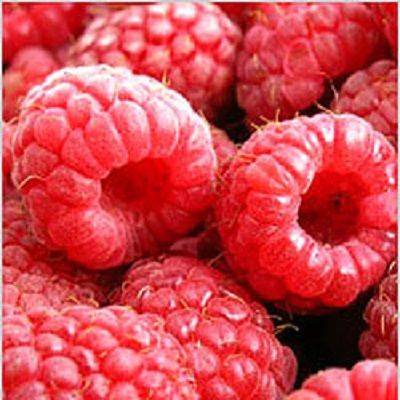

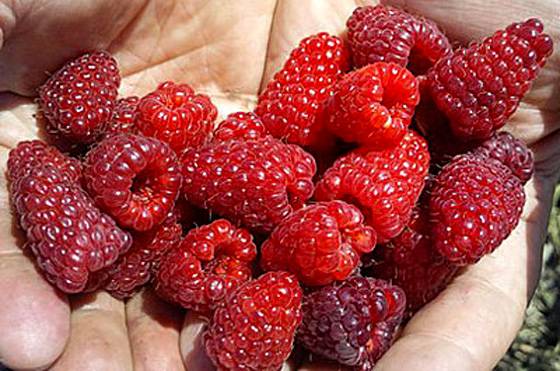
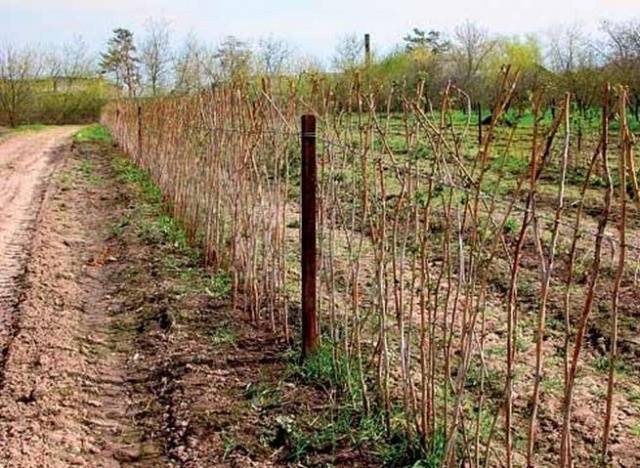
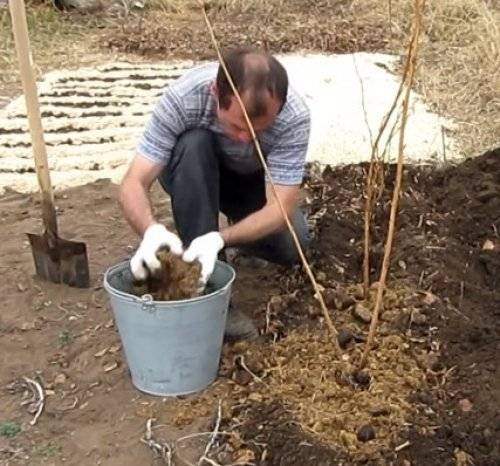


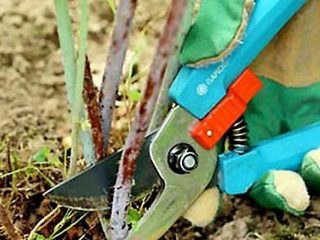
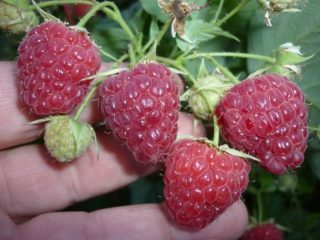






Bought today a Shiny raspberry bush and planted it in a large container. We have snow up to a meter in the garden. I hope that it will take root at home and that we will plant a live bush in the garden.